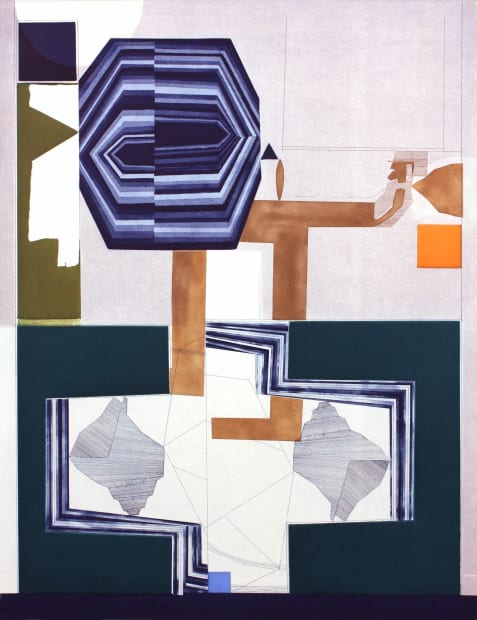-

We did it (Coloring Page-Watts), 2017
Edition 5 of 12
silkscreen with hand coloring
22 x 30 in (55.9 x 76.2 cm)
25 1/8 x 33 1/2 x 1 1/2 in (63.8 x 85.1 x 3.8 cm) framed
OJA 25
-

Plunged Into It, 2010
4 plate color aquatint etching, Somerset white paper
Edition 29 of 40
31 x 24 in (78.7 x 61 cm)
38 5/8 x 28 5/8 x 1 5/8 in (98.1 x 72.7 x 4.1 cm) framed
SOD 60cc
-

We Do Not Advance Through Fixed Gradations, 2010
3 plate color aquatint etching, Somerset white paper
Edition 24 of 40
31 x 24 in (78.7 x 61 cm)
38 5/8 x 28 5/8 x 1 5/8 in (98.1 x 72.7 x 4.1 cm) framed
SOD 62x
-
Katrina Moorhead
Two botanicals float in a field of black, one overlaid on the other. The plants are cropped at the right suggesting movement out of the picture plane, and they leave a contemplative void to the left of the composition. Both botanicals depict the robust and hardy sea pink, a flowering plant found across the northern hemisphere, and that for Moorhead resonates specifically with her native Northern Ireland. The sea pink lives on the coast amid rocky soil and salty sea air conditions, and the plant is described as a survivor. Moorhead set out to make a portrait of this plant using a traditional rendering (seen in color) and a ‘spirited’ rendition of the plant taken from a 100-year-old drawing by Charles Rennie MacIntosh (seen in black). For Moorhead, this portrayal of the plant describes its emotional qualities and collapses time, further emphasizing the plant as a survivor.
-
 Robyn O'Neil
Robyn O'NeilCovenant Trace, 2013
Edition 2 of 50 + 10 AP
2-run 2-color soft ground etching with waterbite aquatint on Magnani Pescia White 300 g/m
22 1/8 x 25 3/4 in (56.2 x 65.4 cm)
22 7/8 x 26 5/8 x 1 1/4 in (58.1 x 67.6 x 3.2 cm) framed
RON 251
Covenant Trace is a direct gravure created by transferring O’Neil’s original drawing on mylar to a copper etching plate through the photogravure process. A second run used water bite, an aquatint etching technique, to make the distinctive vignetting that beckons viewers into O’Neil’s drawn world. To produce the painterly effect, which is distinctive for its subtle shift from dark to light, aquatint ground was used to paint the shape of the vignetting frame on a copper plate. Next, one side of the plate was partially submerged at a slight incline in a water bath, and a printer gradually added acid to the bath. Because acid is denser than water, in the water bite process the acid sinks to the bottom of the bath; thus, the deepest etch occurs along the bottom of the plate. A progressively lighter etch is created higher up, where acid creeps up and mingles with the water bath as a printer adds more. To produce the halo-like effect around O’Neil’s drawing, this process was repeated four times for each edge of the plate.
-
 Portal, 2018 Edition 3 of 20 silkscreen on Yupo paper 24 x 18 in (61 x 45.7 cm) 29 x 23 x 1 in (73.7 x 58.4 x 2.5 cm) framed TF 157Tommy Fitzpatrick
Portal, 2018 Edition 3 of 20 silkscreen on Yupo paper 24 x 18 in (61 x 45.7 cm) 29 x 23 x 1 in (73.7 x 58.4 x 2.5 cm) framed TF 157Tommy FitzpatrickPortal, 2018
Edition 3 of 20
silkscreen on Yupo paper
24 x 18 in (61 x 45.7 cm)
29 x 23 x 1 in (73.7 x 58.4 x 2.5 cm) framed
TF 157
Portal was printed in the fall of 2018 at Texas State University, assisted by Rand Renforw. The image is based on a maquette that I created out of plexiglass screen printed on Yupo paper. I chose Yupo becuase its a plastic paper, which I felt was appropriate for making work about plexiglas and the synthetic.
-

Deep Stain, 2014
unique silkscreen
26 x 20 in (66 x 50.8 cm)
31 1/8 x 25 1/4 x 1 1/2 in (79.1 x 64.1 x 3.8 cm) framed
BT 391
-

Cat / the Skeptic, 2021
Edition 1 of 15 + 2 AP
archival digital print on German etching paper
29 x 18 1/2 in (73.7 x 47 cm)
30 x 19 1/8 x 1 1/4 in (76.2 x 48.6 x 3.2 cm) framed
BS 314-1
PrintHouston 2022: A selection of prints by gallery artists
Past viewing_room









